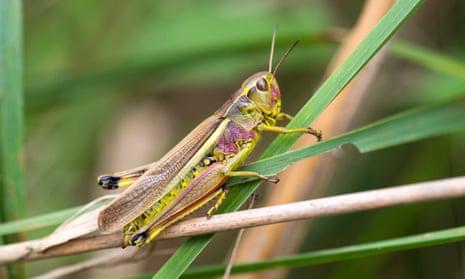Britain’s largest grasshopper is being bred in captivity by citizen zookeepers and returned to marshes across East Anglia in a move to revive the endangered species.
The large marsh grasshopper, an elusive green insect that can appear in a striking pink-and-yellow form, is too isolated in fragments of wetland to hop back to its former strongholds.
So volunteers for Citizen Zoo, a social enterprise that promotes rewilding and community engagement, are releasing about 1,000 grasshoppers at two secret sites this summer.
The project, which is licensed by Natural England, the government’s conservation agency, has already released 2,152 “hoppers” – mainly adults but a few still at nymph stage – into the countryside. The first wild offspring from the newly released grasshoppers emerged on a nature reserve managed by Norfolk Wildlife Trust last summer.
Until the translocation began, the grasshopper only survived in the wild in Britain in wet flushes within the New Forest and at a few sites in Dorset and Somerset. The grasshoppers require heat and wind to disperse and even then the males – which call by making a discreet clicking sound – rarely travel more than 50 metres.
“Because of habitat fragmentation and climate change, it’s likely to go extinct in the next 25 years if we don’t do anything,” said Lucas Ruzo, the chief executive of Citizen Zoo. “A lot of sites where it once was have now been restored so it’s a really good candidate for reintroduction. We hope it could be a symbol for wider landscape restoration and this project will encourage a more proactive approach to conservation which is often lacking.”
Wild grasshoppers are collected from the New Forest under licence and their eggs harvested. Captive rearing for rewilding projects is normally undertaken by zoos but this is expensive and Citizen Zoo also seeks to involve ordinary people in wildlife restoration, particularly because some rewilding projects are criticised for being elitist.
The volunteer keepers, who include an entrepreneur, retirees and students living in London and Cambridgeshire, are given equipment and training and must collect fresh grass for the grasshopper nymphs every day.
Keepers are also trained in biosecurity, with no one allowed to participate if their dogs and cats are given chemical flea treatments that can kill the grasshoppers. Keeping other exotic pets is also banned to minimise the risk of contamination or disease spread.
Each keeper must commit to feeding two cohorts of nymphs fresh grass every day for a three-month period.
Mark Welch, a retired mineralogist from the Natural History Museum, is currently nurturing 100 grasshopper nymphs, which are kept in a glass tank heated by old-fashioned lightbulbs at his home in Ely, Cambridgeshire.
“It has been easier than I expected but in the later stages they eat a lot and you’re going out daily to get fresh cock’s-foot grass for them,” he said.
“When the adults start appearing, the males make this ticking noise, flicking their wings rather than rubbing it. They are charismatic things and it’s nice to handle them and let them sit on your finger.
“It is exciting to be part of putting them back into a place where they’ve been extinct for 50 years and it’s gratifying to feel that you’re making a small contribution.”
The grasshoppers will be released at two protected sites in Norfolk later this summer, while more will be released on to two wetland sites in Cambridgeshire next year. As well as wildlife charities, private landowners have approached Citizen Zoo about returning the grasshopper to more locations across its former range in southern England.
